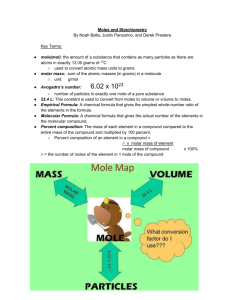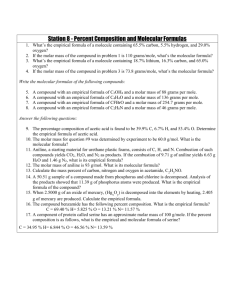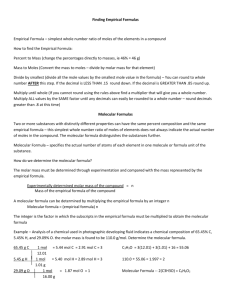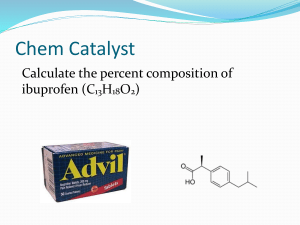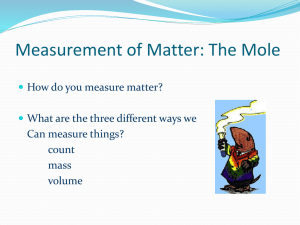Ex: Calculate the % composition (by mass) of Na 2 O
advertisement
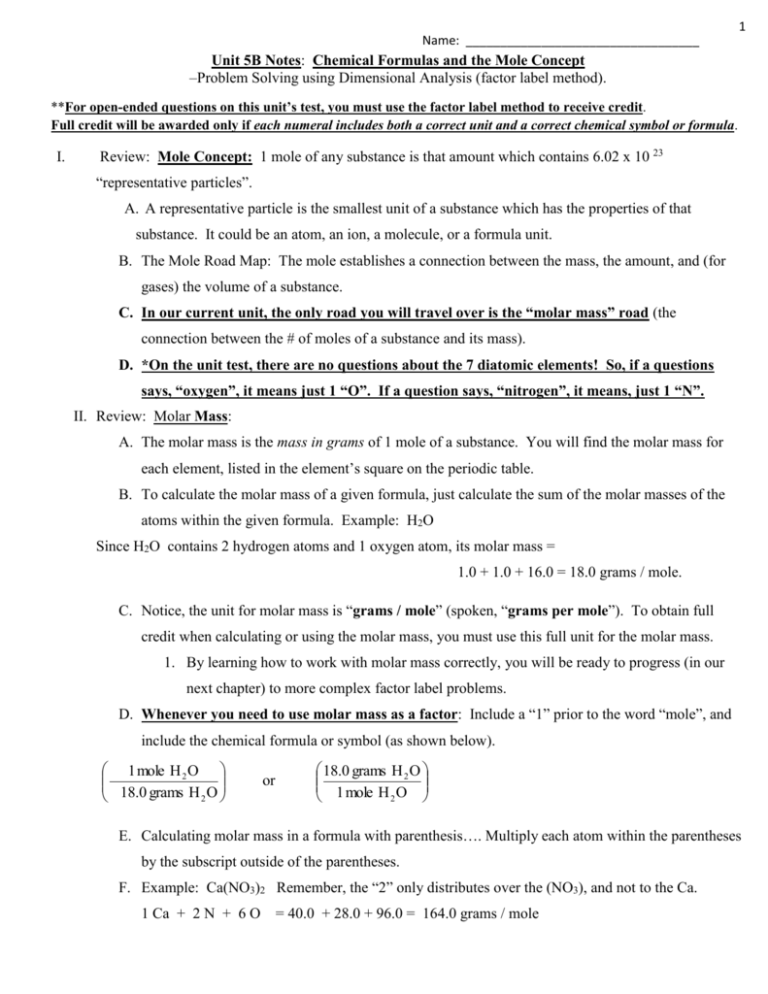
1 Name: __________________________________ Unit 5B Notes: Chemical Formulas and the Mole Concept –Problem Solving using Dimensional Analysis (factor label method). **For open-ended questions on this unit’s test, you must use the factor label method to receive credit. Full credit will be awarded only if each numeral includes both a correct unit and a correct chemical symbol or formula. I. Review: Mole Concept: 1 mole of any substance is that amount which contains 6.02 x 10 23 “representative particles”. A. A representative particle is the smallest unit of a substance which has the properties of that substance. It could be an atom, an ion, a molecule, or a formula unit. B. The Mole Road Map: The mole establishes a connection between the mass, the amount, and (for gases) the volume of a substance. C. In our current unit, the only road you will travel over is the “molar mass” road (the connection between the # of moles of a substance and its mass). D. *On the unit test, there are no questions about the 7 diatomic elements! So, if a questions says, “oxygen”, it means just 1 “O”. If a question says, “nitrogen”, it means, just 1 “N”. II. Review: Molar Mass: A. The molar mass is the mass in grams of 1 mole of a substance. You will find the molar mass for each element, listed in the element’s square on the periodic table. B. To calculate the molar mass of a given formula, just calculate the sum of the molar masses of the atoms within the given formula. Example: H2O Since H2O contains 2 hydrogen atoms and 1 oxygen atom, its molar mass = 1.0 + 1.0 + 16.0 = 18.0 grams / mole. C. Notice, the unit for molar mass is “grams / mole” (spoken, “grams per mole”). To obtain full credit when calculating or using the molar mass, you must use this full unit for the molar mass. 1. By learning how to work with molar mass correctly, you will be ready to progress (in our next chapter) to more complex factor label problems. D. Whenever you need to use molar mass as a factor: Include a “1” prior to the word “mole”, and include the chemical formula or symbol (as shown below). 1 mole H 2 O 18.0 grams H 2 O or 18.0 grams H 2 O 1 mole H 2 O E. Calculating molar mass in a formula with parenthesis…. Multiply each atom within the parentheses by the subscript outside of the parentheses. F. Example: Ca(NO3)2 Remember, the “2” only distributes over the (NO3), and not to the Ca. 1 Ca + 2 N + 6 O = 40.0 + 28.0 + 96.0 = 164.0 grams / mole 2 III.. Review: factor label method: The numerical information in each problem should be identified as: 1. “what you are given” with its unit 2. “what you want to know” with its unit 3. a “conversion factor” that relates the two units – written in the form of an equivalency and/or a fraction. Then, start with what you are given, and multiply by the conversion factor in order to cross off the given unit. Guided Practice: How many moles of carbon are in a sample containing 60.00 grams of carbon? By circling the “want to know” and underlining the “given”, you identify the units to use in the conversion factor. Additionally, underlining the “given” helps you remember that it will be used in the position of a numerator. 1. --Given: 60.00 grams C 2. --Want to know: As with any chemistry calculation, pay attention to sig figs! moles of C 3. Identify the correct conversion factor: The conversion factor for a change between “moles” and “mass” of a given substance is the substance’s molar mass! Find the molar mass in carbon’s square on the periodic table. Conversion factor: 12.0 grams C = 1 mole C 4. Start the factor label setup with “what you are given”, written as a numerator (be sure to include the unit and chemical symbol or formula). Place a multiplication sign to its right and draw a set of ( ) within which to place a factor. 60.00 grams C x ( ) = 5. Purposefully set up your conversion factor as a fraction, so that its denominator (bottom) unit is identical with, and thus will cancel out with, the unit present in the “given”. Only cancel the unit, not the number! 60.00 grams C x 12.0 grams C 6. After filling in the denominator correctly (number and cancelled unit), fill in the numerator with the rest of the factor. 1 mole C 60.00 grams C x 12.0 grams C 7. Last, use your calculator to multiply all the top numbers, and divide by all the bottom numbers. Memory aid: MTDB, or, MighTy Duck Bottoms– Multiply All Tops Divide By All Bottoms 1 mole C 5.00 moles C 60.00 grams C x 12.0 grams C Last, check that your answer’s unit is what you originally “wanted”. Notice how each number in the setup and in the answer has both a unit and either a chemical symbol or formula. 3 IV. The Mole Ratio within a given Formula: A. If you have 1 formula unit of an ionic compound, or 1 molecule of a covalent compound, you know that it contains a given number of ions or atoms: 2, 3, … as indicated by the subscripts in the formula. B. Similarly, if you have 1 mole of the compound, you have a given number of _____________ of ions or atoms (2, 3,…) again as indicated by the subscripts in the formula. See below: c. Practice Interpreting Formulas of Ionic and Covalent Compounds: It is the SUBSCRIPTS that tell you the ratios. In 1 formula unit of this substance: There are: And, in 1 mole of this same substance, there are: a. Ba(NO3)2 1 Ba ion 2 NO3 ions b. K2S __K ions ___ S ions _____________________________________ c. Mg2(SO4)3 ___Mg ions ___SO4 ions _____________________________________ d. (NH4)3PO4 ____NH4 ___PO4 ions _____________________________________ e. NaHCO3 ____ Na ___HCO3 ion _____________________________________ In 1 molecule of this substance: ions ion There are: 1 mole Ba 2 moles NO3 And, in 1 mole of this substance, there are: f. Br2 2 Br atoms 2 moles Br g. PCl5 1 P atom 5 Cl atoms 1 mole P h. Si2Br6 _ Si atoms _ Br atoms ________________________________________ i.. Methane (CH4) __ C atom __ H atoms __________________________________________ j. Ammonia (NH3) __ N atom __ H atoms __________________________________________ 5 moles Cl V. Determining the “Percent Composition of a Compound ” based on the mass contributed by each element in the compound. A. When given the mass of the each element used to make the compound, as long as you are told that the elements “combine completely” (meaning nothing extra is left over after making the compound), you may do a simple % calculation. 1) This means, for each element present, divide the individual mass by the total mass: “part” / “total”. 2) And then, multiply x 100. Example: 23.0 grams of Na combines completely with 8.0 grams of O to form a compound. Determine the percent composition of “O” in the compound part x 100 total 16.0 grams (23.0 8.0) grams x 100 16.0 grams 31.0 grams 25.8 % O 4 Practice: 64.0 grams of Cu combines completely with 16.0 grams of S to form a compound. Determine the percent composition of Cu in the compound. VI. Calculating the % composition (by mass) of a compound, given only its chemical formula: If you are NOT given the actual masses of the elements used to make the compound, you may still determine the % composition of the compound; but, you will have to be given its formula. Steps: 1) Assume there is exactly 1 mole of the given compound. This allows the subscripts in the formula to be used to calculate the # of moles of each atom in the compound. 2) Use the periodic table to look up the molar mass for each atom in the compound. 3) Multiply the molar mass of each atom by its subscript. 4) Determine the molar mass of the entire compound (add together the molar masses from step C). 5) Calculate the percent contribution for each element in the compound: 6) Divide and multiply for each atom: (individual Step 3 answer / Step 4 sum) x 100 = % (individual Step 3 answer / Step 3 sum) x 100 = % Etc. for each element in the compound Ex: Calculate the % composition (by mass) of Na2O Na2 = O= Na2O = 23.0 x 2 = 16.0 x 1 = 46.0 + 16.0 = 46.0 g / mole +16.0 g / mole 62.0 g / mole Na 2 x 100 Na 2 O 46.0 g/mole x 100 74.2 % Na 62.0 g/mole *As can be seen here, the only things needed in order to determine the % composition of a compound are the formula of the compound and the molar mass (also called “atomic mass”) of its elements! 16.0 g/mole O x 100 x 100 25.8 % O 62.0 g/mole Na 2 O Practice Question: Determine which compound has the lowest % Cu and which compound has the highest % Cu (by mass). Compounds: Cu2O Show your work for each compound! CuOH CuCN Cu2S 5 VII. Distinguishing between a “Molecular Formula” and an “Empirical Formula” A. Empirical formulas are the reduced, simplified, lowest whole number ratio of atoms or ions in a compound’s formula. We always use an empirical formula when specifying an ionic compound. B. Molecular formulas are not reduced or simplified. They show the actual numbers of atoms in 1 molecule of a molecular element or a molecular compound. 1) While we should always use a molecular formula when it is known, there are times in which a chemist doesn’t know the molecular formula; instead, he/she only knows the empirical formula for a given molecular substance. a In this case, since molecular formulas will always be a whole number multiple of their empirical formula, it is possible to calculate the molecular formula. b A molecular formula will always be either equal to or larger than its empirical formula. c C1H2O1 CH2O is an empirical formula. Possible molecular formulas for it are: x1 x2 x3 x4 CH2O C2H4O2 C3H6O3 C4H8O4 Formaldehyde is the chemical that is used to embalm a body. x5 x6 = C5H10O5 C6H12O6 Glucose is the sugar that nourishes our body’s cells. Notice how it is possible for different molecules to have the same empirical formula. Practice Questions: 1. Circle the empirical formulas in the list below: Al2H6 AlH3 C4H8 Ca2(SO4)2 Mg(C2O4)2 NaC2H3O2 2. The molecular formula for vitamin C is C6H8O6. What is its empirical formula? [Just divide by the greatest common denominator.] ___________________ 3. A chemistry student performs an experiment and concludes that this is the proper formula: H0.50 O0.25 When asked to explain, the student says, “Well, the data gave me a ratio of 0.50 moles H for every 0.25 moles O. What is the correct empirical formula for this common molecular substance? [Just divide by the greatest common denominator.] ______________________ 4. The compound known as “benezene” has this molecular formula: C6H6. The compound known as “acetylene” has this molecular formula: C2H2. What is the empirical formula for these 2 substances? ______________________ 6 VIII. Determining a compound’s empirical formula. If you are given the % composition (by mass) of a compound, you can determine its empirical formula. Example: The % composition by mass of a compound is: 76.54% C, 12.13% H, 11.33% O. Calculate its empirical formula. Step 1: Calculate the number of moles of each element present: As long as the percentages add up to 100, you may immediately change the unit from % to “grams”. Then, do a factor label conversion to moles. 1 mol 6.37 mol C 76.54 % C 76.54 g C x 12.0 g C 1 mol 12.0 mol H 12.13 % H 12.13 g H x 1.0 g H 1 mol 0.708 mol C 11.33 % O 11.33 g C x 16.0 g O Step 2: Determine the “smallest whole number ratio” for each element: Just divide each of the previous answers by the smallest of those answers. 6.37 mol C 0.708 9.00 mol C 12.0 mol H 0.708 17.0 mol H 0.708 mol O 0.708 1.00 mol O 9 mol C 17 mol H 1 mol O As long as each answer is a whole number (or within + or – 0.1 mole of a whole number), you may use those answers as the subscripts for an empirical formula. Step 3: Write an empirical formula from the mole ratio: C9H17O1 *Note: If, instead of having subscripts which are all whole numbers, you have at least one subscript which contains a decimal or fractional quantity, then there is an additional step (because by definition, empirical formulas must use the lowest whole number ratio of atoms). In this additional step, you multiply that subscript (the non-whole number) by an integer between 2 and 10, in order to give you a whole number. Then multiply the other subscripts by this same integer. Example: You are given a % composition for a compound, do everything correctly, and get this empirical formula: C1.5 H3 O1 How should you adjust this to become a true empirical formula? Multiply (1.5) by the lowest integer between 2 and 10, so that the product is a whole number. Since 1.5 x 2 = 3 (a whole number)….You now have to multiply each of the remaining subscripts by 2 as well. Correct formula: C3H6O2 Practice question: The % composition by mass of a compound is: 82.4% N, 17.6% H. Calculate its empirical formula. Show work here. Practice question: You use a given % composition for a compound and determine this to be its empirical formula: KCrO3.5. Determine the correct empirical formula. 7 IX. Calculating a compound’s molecular formula. If you are given molecule’s empirical formula and its “molecular mass” (a term often used for a molar mass of a molecular substance), you can calculate its molecular formula. Example: Determine the molecular formula of a compound having P2O5 as an empirical formula. The compound’s molar mass is 283.9 g/mole. Step 1: Calculate molar mass of the empirical formula: (2 x 31.0) (5 x 16.0) 141.9 g / mole Step 2: Divide the molar mass of the compound by the molar mass of the empirical formula: 283.9 g/mole 141.9 g/mole 2 Step 3: Multiply each subscript of the empirical formula by the whole number answer from step 2: 2 x (P2O5 ) = P4O10 Practice Questions: 1. Calculate the molecular formula of a compound whose empirical formula is C3H7. The compound’s molar mass is 86.0 g / mole. Show work here: 2. Calculate the molecular formula of a compound whose empirical formula is CH. The compound’s molar mass is 78.0 g / mole. Show work here: 3. “Sulfur” is an element that occurs in different forms in nature. When an element takes different forms, the different forms are called its “allotropes”. Calculate the molecular formula for one of sulfur’s allotropes - its empirical formula is “S”; and the molar mass for this allotrope is 256.8 g / mole. Show work here: There are times when a chemist doesn’t know a molecular substance’s empirical formula; instead, the chemist only knows the percent composition of the compound and the molar mass of the compound. It is still possible to determine the molecular formula. -In “part 1”, the empirical formula must be calculated from the percent composition of the compound. -Then, in “part 2”, since the molar mass is given, the molecular formula can be calculated from the empirical formula. You have already learned how to do part 1 and part 2. Now, just put them together. See example next page: 8 Example: The % composition by mass of a compound is: 76.54% C, 12.13% H, 11.33% O. The compound’s molecular mass = 282.45 g/mole. Calculate the molecular formula. Part 1— Step 1: Calculate the number of moles of each element present: Change the unit from % to “grams”. Then, do a factor label conversion to moles. 1 mol 6.37 mol C 76.54 % C 76.54 g C x 12.0 g C 1 mol 12.0 mol H 12.13 % H 12.13 g H x 1.0 g H 1 mol 0.708 mol C 11.33 % O 11.33 g C x 16.0 g O Step 2: Determine the “smallest whole number ratio” for each element: 6.37 mol C 0.708 9.00 mol C 12.0 mol H 0.708 17.0 mol H 0.708 mol O 0.708 1.00 mol O 9 mol C 17 mol H 1 mol O As long as each answer is a whole number (or within + or – .1 mole of a whole number), you may use those answers as the subscripts for an empirical formula. If each subscript is NOT a whole number, then you will have to multiply by consecutive integers until you hit the lowest formula using all whole numbers. Step 3: Write an empirical formula from the mole ratio: C9H17O1 Part 2: OK, so now that you have an empirical formula (C9H17O1), continue the problem by determining this empirical formula’s molar mass: Step 1: Calculate the molar mass of empirical formula: (9 x 12.01) + (17 x 1.01) + (1 x 16.00) = 141.26 g / mol Step 2: Molecular formulas are whole number multiples of empirical formulas. So, you need to determine how many times larger the mass of the molecule is, compared to the molar mass of its empirical formula: Molecular mass (information given in the original problem) ÷ molar mass of empirical formula: 282.45 ÷ 141.26 = 2 Step 3: Multiply each of the subscripts in your empirical formula by the whole number answer to the above division problem: (C9H17O1 ) x 2 = C18H34O2


